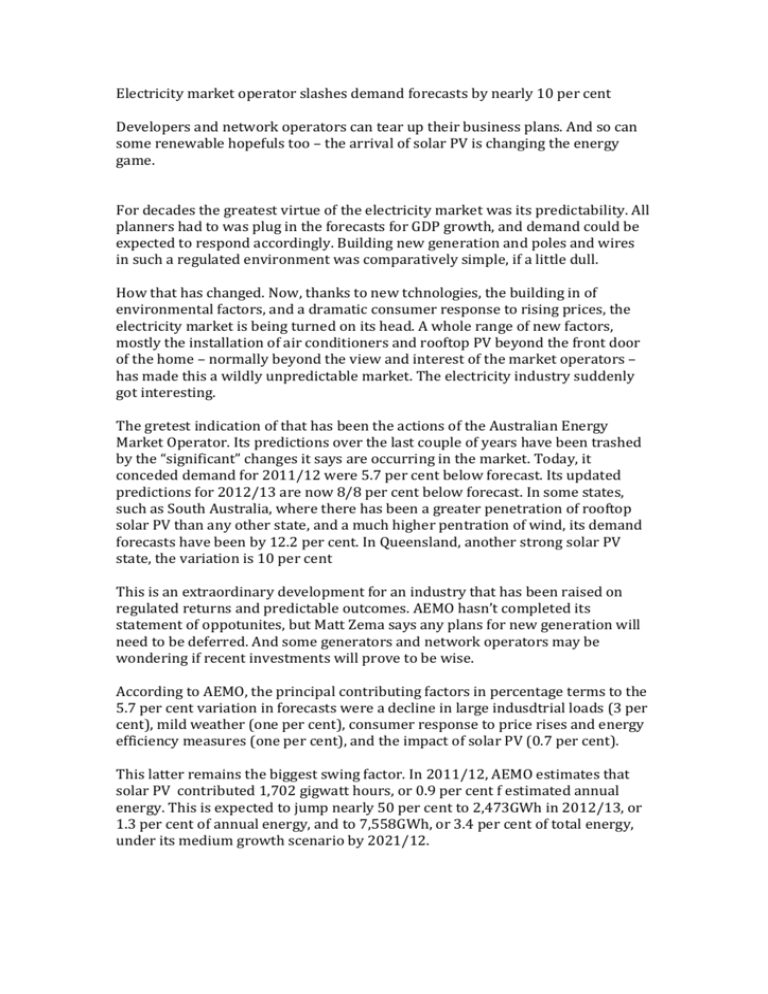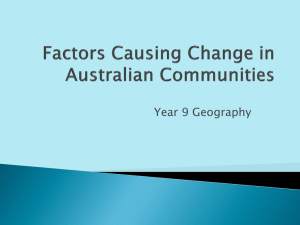aemo-forecasts
advertisement

Electricity market operator slashes demand forecasts by nearly 10 per cent Developers and network operators can tear up their business plans. And so can some renewable hopefuls too – the arrival of solar PV is changing the energy game. For decades the greatest virtue of the electricity market was its predictability. All planners had to was plug in the forecasts for GDP growth, and demand could be expected to respond accordingly. Building new generation and poles and wires in such a regulated environment was comparatively simple, if a little dull. How that has changed. Now, thanks to new tchnologies, the building in of environmental factors, and a dramatic consumer response to rising prices, the electricity market is being turned on its head. A whole range of new factors, mostly the installation of air conditioners and rooftop PV beyond the front door of the home – normally beyond the view and interest of the market operators – has made this a wildly unpredictable market. The electricity industry suddenly got interesting. The gretest indication of that has been the actions of the Australian Energy Market Operator. Its predictions over the last couple of years have been trashed by the “significant” changes it says are occurring in the market. Today, it conceded demand for 2011/12 were 5.7 per cent below forecast. Its updated predictions for 2012/13 are now 8/8 per cent below forecast. In some states, such as South Australia, where there has been a greater penetration of rooftop solar PV than any other state, and a much higher pentration of wind, its demand forecasts have been by 12.2 per cent. In Queensland, another strong solar PV state, the variation is 10 per cent This is an extraordinary development for an industry that has been raised on regulated returns and predictable outcomes. AEMO hasn’t completed its statement of oppotunites, but Matt Zema says any plans for new generation will need to be deferred. And some generators and network operators may be wondering if recent investments will prove to be wise. According to AEMO, the principal contributing factors in percentage terms to the 5.7 per cent variation in forecasts were a decline in large indusdtrial loads (3 per cent), mild weather (one per cent), consumer response to price rises and energy efficiency measures (one per cent), and the impact of solar PV (0.7 per cent). This latter remains the biggest swing factor. In 2011/12, AEMO estimates that solar PV contributed 1,702 gigwatt hours, or 0.9 per cent f estimated annual energy. This is expected to jump nearly 50 per cent to 2,473GWh in 2012/13, or 1.3 per cent of annual energy, and to 7,558GWh, or 3.4 per cent of total energy, under its medium growth scenario by 2021/12. “forecast increases in rooftop solar photovoltaic system allocations are expected to offset a large amount of electriity that would have otherwise been provided by the NEM,” AEMO says. And this is the key for generators – both incumbent and aspiring coal and gas generators, and for renewable energy players. This graph shws how AEO’s forecasts for 2021/22 have changed in a matter of 12 months. The difference between the high growth forecast of last year and the low growth forecast from this year is 30 per cent. Given This has considerable implications for incumbent generators. Lower demand has already had a biting impact n whelsale electricity prices, and profit margins, for the largest generators. Wen origin Energy ‘s Grant King tld RenewEconomy there was no need for new baseload before the end of the decade, that was based around Origin Energy’s forecasts of around 250 terrawatt hours. AEM’s highest forecast is for less than 240TWh in 2020, its median forecast is for less than 220TWh and it says it could be as low as 200TWh – a full 20 per cent belw Origin’s estimate of just three months ago. That in turn, will increase the stakes of the review into the Renewable Energy Target being undertaken by the newly created Climate Change Commission later this year. In May, King argued that the RET should reflect actual demand rather than a fixed amount of renewable energy production (a total of 41,000TWh To add to the pre-existing hydro capacity of 15,000TWh. Even though origin Energy had previously argud for a fixed target, it now argues that tis would represent nearly 25 per cent if including solar PV. That number jumps to nearly 30 per cent under AEM’s revised frecasts. You can be sure that Origin Energy and others will be arguing their case. But if it was morphed to an actual percentage, then te new build renewables could fall by more than half – a disaster for the wind and solar industries in this country. Under these new c For the first time, it has been moved to release a specific forecasting report separate from its statement of opportunities – essentially a buyers guide to energy that served as a bible to the industry. The revised energy demand forecasts to be released by the Australian Energy Market Operator today (Friday) represent the most dramatic change in the Australian electricity industry in more than five decades. Energy demand in 2011/12 has been 5.7 per cent below its prediction made just a year ago, the result of lower industrial use, milder weather, energy efficiency measures, and the impact of rooftop solar PV. Its revised predictions for 2012/13 are 8.8 per cent below those made just a year ago - a recognition that solar PV will have an ever growing impact on grid demand. This has an impact not just on developers of conventional coal and gas generation – many of whose plans have been put back years, if not for good. It may also create issues for renewable energy generation too. Lower demand is pushing wholesale electricity prices down to record lows, and this may make it difficult to strike the power purchase agreements necessary to finance their deployment. The real game changer, though, is solar PV. In some states such as South Australia, it accounts for 2.4 per cent of production, and is tipped to more than double in coming years. Australia-wide the production of electricity from rooftop PV will at least treble by 2020/21. That’s good news for consumers who can find a cheaper source of energy than the coal-dominated grid, but it’s presents a challenge to the business models of larger generators.







